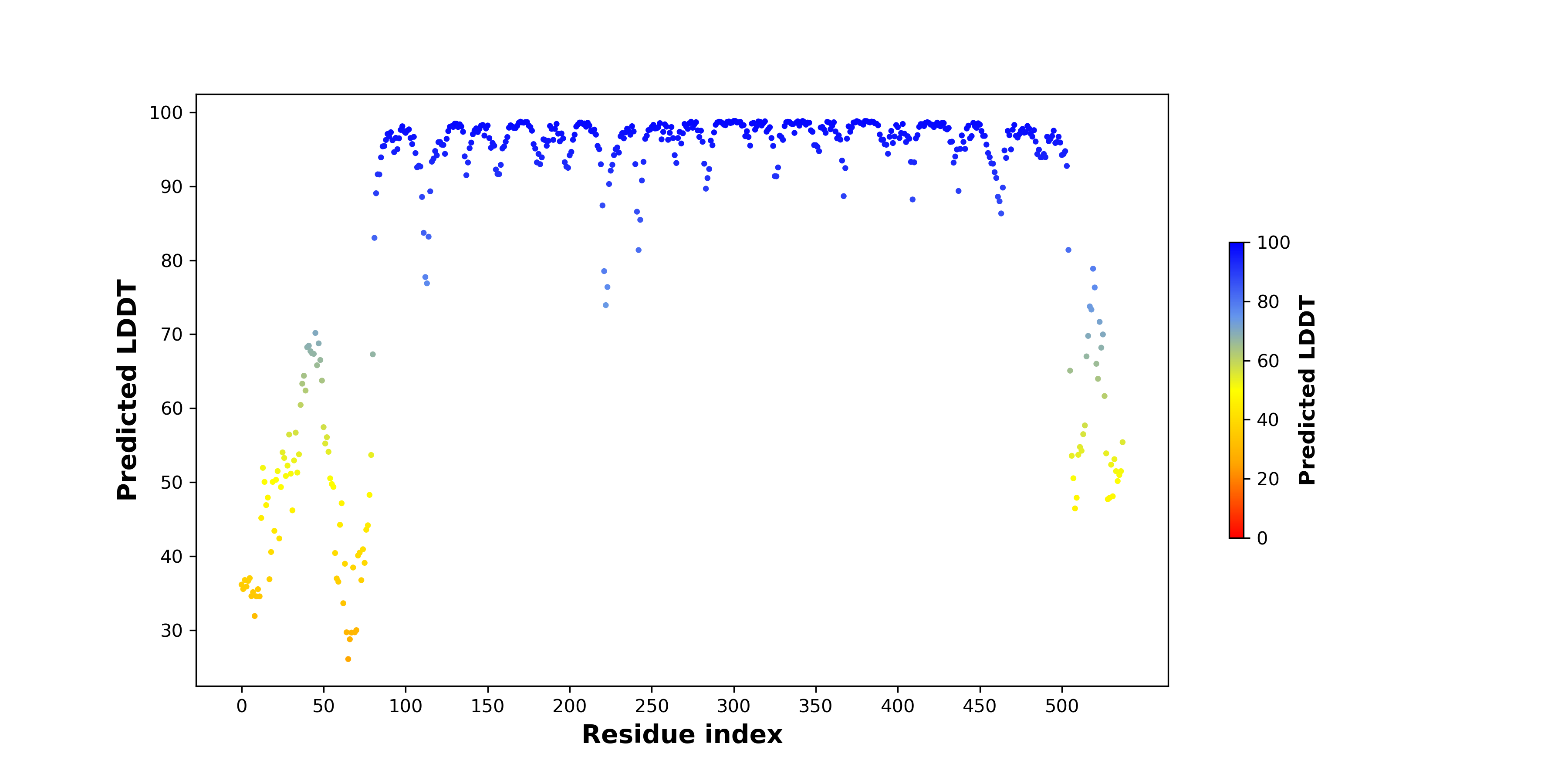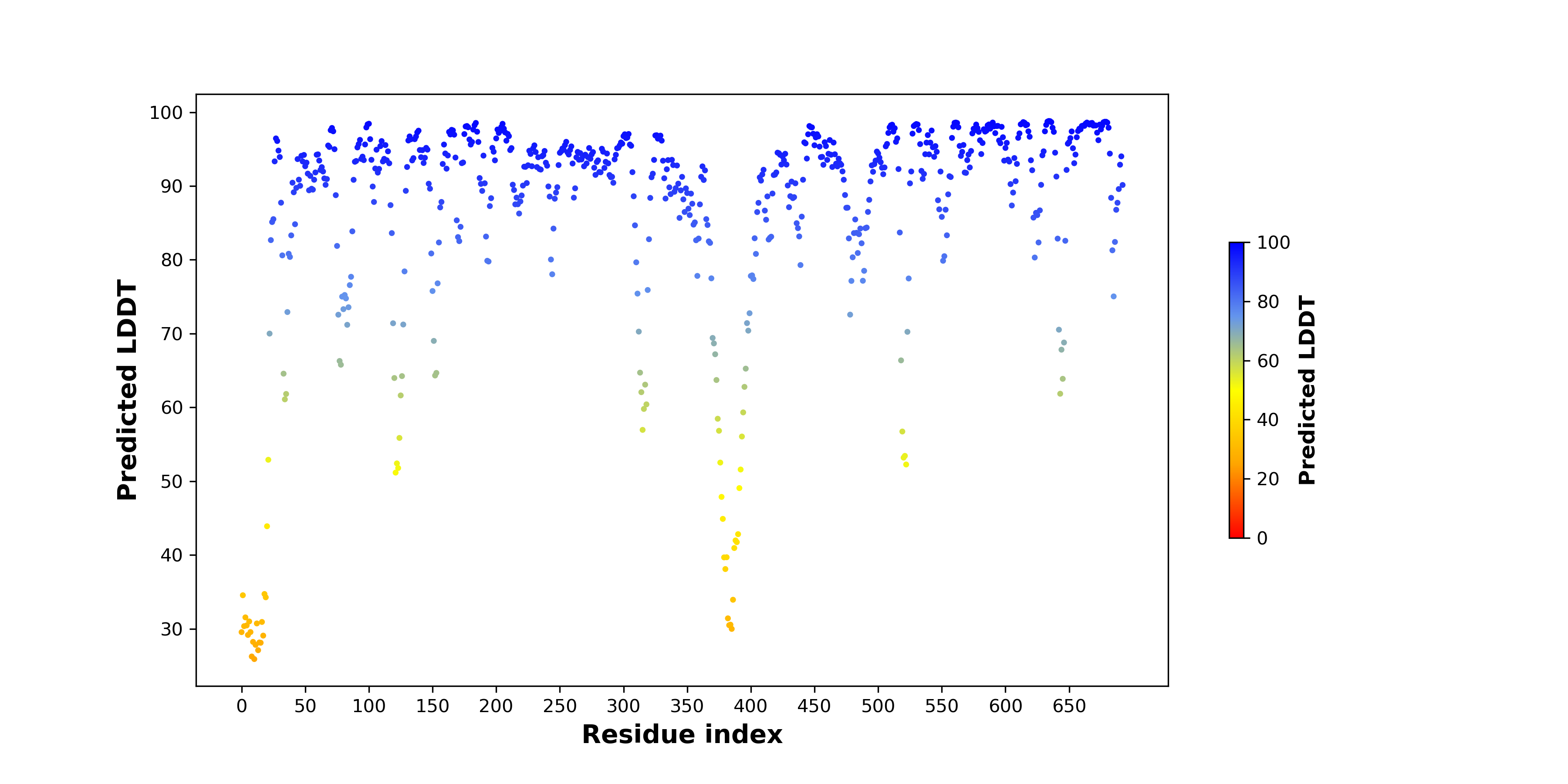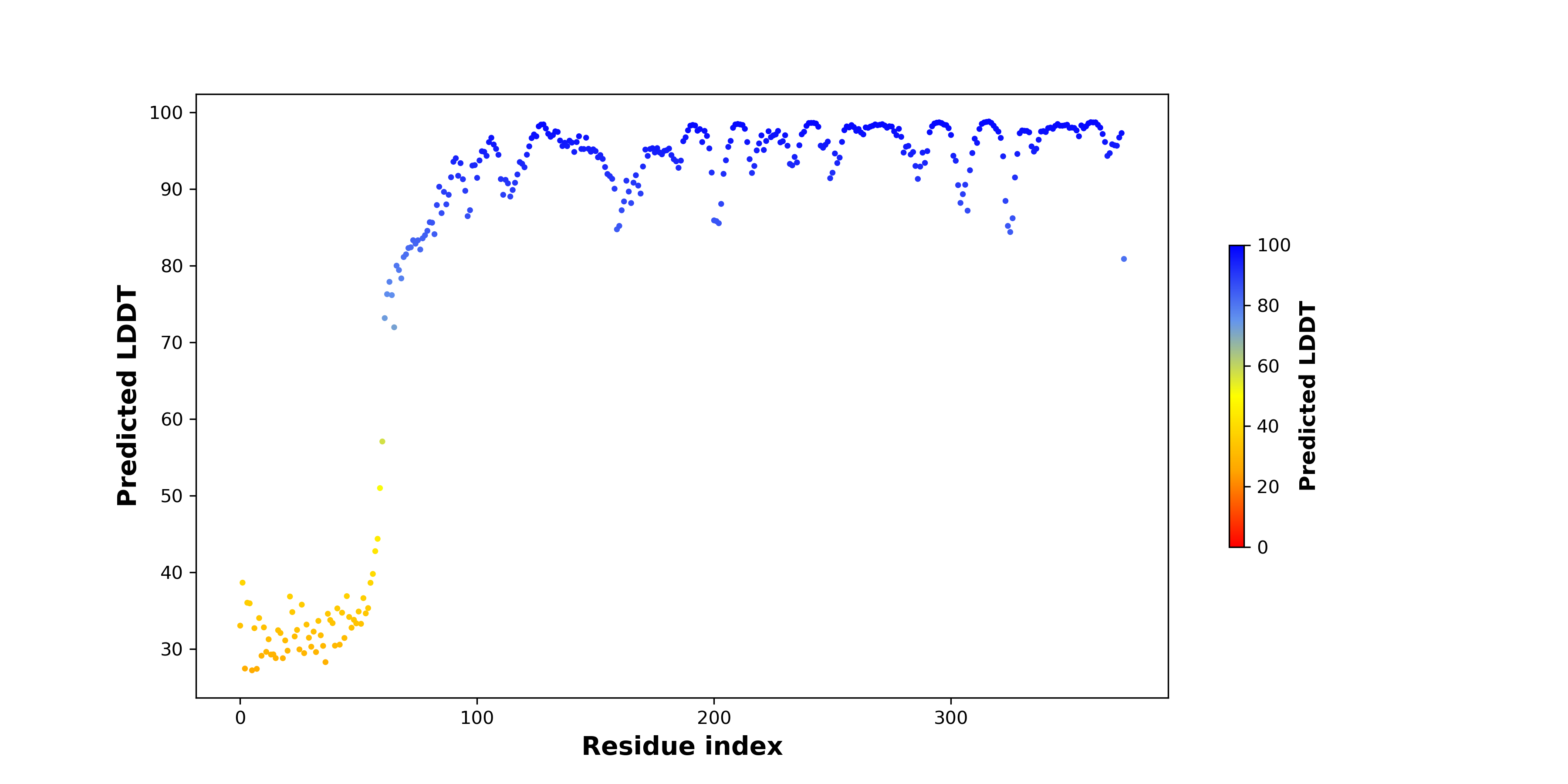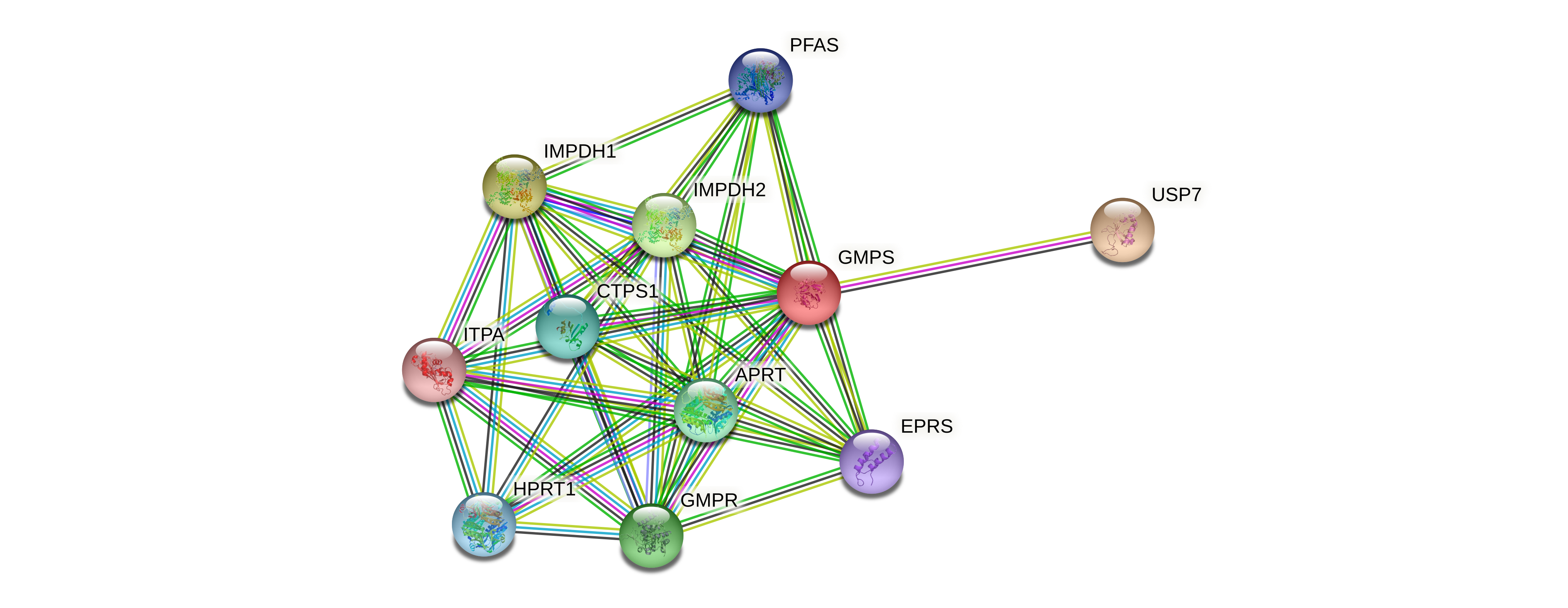| UTHEALTH HOME ABOUT SBMI A-Z WEBMAIL INSIDE THE UNIVERSITY |

|
|||||||
|
Fusion Protein:KPNA1-GMPS |
Fusion Protein Summary |
 Fusion gene summary Fusion gene summary |
| Fusion partner gene information | Fusion gene name: KPNA1-GMPS | FusionPDB ID: 43360 | FusionGDB2.0 ID: 43360 | Hgene | Tgene | Gene symbol | KPNA1 | GMPS | Gene ID | 3836 | 8833 |
| Gene name | karyopherin subunit alpha 1 | guanine monophosphate synthase | |
| Synonyms | IPOA5|NPI-1|RCH2|SRP1 | GATD7 | |
| Cytomap | 3q21.1 | 3q25.31 | |
| Type of gene | protein-coding | protein-coding | |
| Description | importin subunit alpha-5RAG cohort protein 2SRP1-betaimportin alpha 5importin subunit alpha-1importin-alpha-S1karyopherin alpha 1 (importin alpha 5)nucleoprotein interactor 1recombination activating gene cohort 2 | GMP synthase [glutamine-hydrolyzing]GMP synthaseGMP synthetaseMLL/GMPS fusion proteinglutamine amidotransferaseguanine monophosphate synthetaseguanosine 5'-monophosphate synthasetesticular tissue protein Li 82 | |
| Modification date | 20200313 | 20200313 | |
| UniProtAcc | P52294 | P49915 | |
| Ensembl transtripts involved in fusion gene | ENST ids | ENST00000344337, ENST00000466923, | ENST00000476145, ENST00000295920, ENST00000496455, |
| Fusion gene scores for assessment (based on all fusion genes of FusionGDB 2.0) | * DoF score | 19 X 10 X 13=2470 | 8 X 7 X 6=336 |
| # samples | 26 | 11 | |
| ** MAII score | log2(26/2470*10)=-3.24792751344359 possibly effective Gene in Pan-Cancer Fusion Genes (peGinPCFGs). DoF>8 and MAII<0 | log2(11/336*10)=-1.6109577092541 possibly effective Gene in Pan-Cancer Fusion Genes (peGinPCFGs). DoF>8 and MAII<0 | |
| Context (manual curation of fusion genes in FusionPDB) | PubMed: KPNA1 [Title/Abstract] AND GMPS [Title/Abstract] AND fusion [Title/Abstract] | ||
| Most frequent breakpoint (based on all fusion genes of FusionGDB 2.0) | KPNA1(122215284)-GMPS(155637022), # samples:3 | ||
| Anticipated loss of major functional domain due to fusion event. | KPNA1-GMPS seems lost the major protein functional domain in Hgene partner, which is a CGC by not retaining the major functional domain in the partially deleted in-frame ORF. KPNA1-GMPS seems lost the major protein functional domain in Hgene partner, which is a CGC by not retaining the major functional domain in the partially deleted in-frame ORF. KPNA1-GMPS seems lost the major protein functional domain in Hgene partner, which is a essential gene by not retaining the major functional domain in the partially deleted in-frame ORF. KPNA1-GMPS seems lost the major protein functional domain in Hgene partner, which is a essential gene by not retaining the major functional domain in the partially deleted in-frame ORF. | ||
| * DoF score (Degree of Frequency) = # partners X # break points X # cancer types ** MAII score (Major Active Isofusion Index) = log2(# samples/DoF score*10) |
 Gene ontology of each fusion partner gene with evidence of Inferred from Direct Assay (IDA) from Entrez Gene ontology of each fusion partner gene with evidence of Inferred from Direct Assay (IDA) from Entrez |
| Partner | Gene | GO ID | GO term | PubMed ID |
| Tgene | GMPS | GO:0006177 | GMP biosynthetic process | 8089153 |
 Fusion gene breakpoints across KPNA1 (5'-gene) Fusion gene breakpoints across KPNA1 (5'-gene)* Click on the image to open the UCSC genome browser with custom track showing this image in a new window. |
 |
 Fusion gene breakpoints across GMPS (3'-gene) Fusion gene breakpoints across GMPS (3'-gene)* Click on the image to open the UCSC genome browser with custom track showing this image in a new window. |
 |
Top |
Fusion Gene Sample Information |
 Fusion gene information from FusionGDB2.0. Fusion gene information from FusionGDB2.0. |
 Fusion gene information from two resources (ChiTars 5.0 and ChimerDB 4.0) Fusion gene information from two resources (ChiTars 5.0 and ChimerDB 4.0)* All genome coordinats were lifted-over on hg19. * Click on the break point to see the gene structure around the break point region using the UCSC Genome Browser. |
| Source | Disease | Sample | Hgene | Hchr | Hbp | Hstrand | Tgene | Tchr | Tbp | Tstrand |
| ChimerDB4 | LUAD | TCGA-78-7147-01A | KPNA1 | chr3 | 122215283 | - | GMPS | chr3 | 155637021 | + |
| ChimerDB4 | LUAD | TCGA-78-7147-01A | KPNA1 | chr3 | 122215284 | - | GMPS | chr3 | 155637022 | + |
| ChimerDB4 | LUAD | TCGA-78-7147 | KPNA1 | chr3 | 122215283 | - | GMPS | chr3 | 155637021 | + |
Top |
Fusion ORF Analysis |
 Fusion information from ORFfinder translation from full-length transcript sequence from FusionPDB. Fusion information from ORFfinder translation from full-length transcript sequence from FusionPDB. |
| Henst | Tenst | Hgene | Hchr | Hbp | Hstrand | Tgene | Tchr | Tbp | Tstrand | Seq length (transcript) | BP loci (transcript) | Predicted start (transcript) | Predicted stop (transcript) | Seq length (amino acids) |
| ENST00000344337 | KPNA1 | chr3 | 122215284 | - | ENST00000496455 | GMPS | chr3 | 155637022 | + | 7510 | 306 | 51 | 1175 | 374 |
| ENST00000344337 | KPNA1 | chr3 | 122215284 | - | ENST00000295920 | GMPS | chr3 | 155637022 | + | 1194 | 306 | 51 | 1175 | 374 |
| ENST00000344337 | KPNA1 | chr3 | 122215283 | - | ENST00000496455 | GMPS | chr3 | 155637021 | + | 7510 | 306 | 51 | 1175 | 374 |
| ENST00000344337 | KPNA1 | chr3 | 122215283 | - | ENST00000295920 | GMPS | chr3 | 155637021 | + | 1194 | 306 | 51 | 1175 | 374 |
 DeepORF prediction of the coding potential based on the fusion transcript sequence of in-frame fusion genes. DeepORF is a coding potential classifier based on convolutional neural network by comparing the real Ribo-seq data. If the no-coding score < 0.5 and coding score > 0.5, then the in-frame fusion transcript is predicted as being likely translated. DeepORF prediction of the coding potential based on the fusion transcript sequence of in-frame fusion genes. DeepORF is a coding potential classifier based on convolutional neural network by comparing the real Ribo-seq data. If the no-coding score < 0.5 and coding score > 0.5, then the in-frame fusion transcript is predicted as being likely translated. |
| Henst | Tenst | Hgene | Hchr | Hbp | Hstrand | Tgene | Tchr | Tbp | Tstrand | No-coding score | Coding score |
| ENST00000344337 | ENST00000496455 | KPNA1 | chr3 | 122215284 | - | GMPS | chr3 | 155637022 | + | 0.001290614 | 0.99870944 |
| ENST00000344337 | ENST00000295920 | KPNA1 | chr3 | 122215284 | - | GMPS | chr3 | 155637022 | + | 0.003952354 | 0.9960477 |
| ENST00000344337 | ENST00000496455 | KPNA1 | chr3 | 122215283 | - | GMPS | chr3 | 155637021 | + | 0.001290614 | 0.99870944 |
| ENST00000344337 | ENST00000295920 | KPNA1 | chr3 | 122215283 | - | GMPS | chr3 | 155637021 | + | 0.003952354 | 0.9960477 |
Top |
Fusion Amino Acid Sequences |
 For individual full-length fusion transcript sequence from FusionPDB, we ran ORFfinder and chose the longest ORF among the all predicted ones. For individual full-length fusion transcript sequence from FusionPDB, we ran ORFfinder and chose the longest ORF among the all predicted ones. |
| >FusionGDB ID_FusionGDB isoform ID_FGname_Hgene_Hchr_Hbp_Henst_Tgene_Tchr_Tbp_Tenst_length(fusion AA) seq_BP >43360_43360_1_KPNA1-GMPS_KPNA1_chr3_122215283_ENST00000344337_GMPS_chr3_155637021_ENST00000295920_length(amino acids)=374AA_BP=85 MVSTAEARASSSRLCAGVARRAGERGANFSGGTGIGCLEPEIMTTPGKENFRLKSYKNKSLNPDEMRRRREEEGLQLRKQKREEQGKVIE PLKDFHKDEVRILGRELGLPEELVSRHPFPGPGLAIRVICAEEPYICKDFPETNNILKIVADFSASVKKPHTLLQRVKACTTEEDQEKLM QITSLHSLNAFLLPIKTVGVQGDCRSYSYVCGISSKDEPDWESLIFLARLIPRMCHNVNRVVYIFGPPVKEPPTDVTPTFLTTGVLSTLR QADFEAHNILRESGYAGKISQMPVILTPLHFDRDPLQKQPSCQRSVVIRTFITSDFMTGIPATPGNEIPVEVVLKMVTEIKKIPGISRIM -------------------------------------------------------------- >43360_43360_2_KPNA1-GMPS_KPNA1_chr3_122215283_ENST00000344337_GMPS_chr3_155637021_ENST00000496455_length(amino acids)=374AA_BP=85 MVSTAEARASSSRLCAGVARRAGERGANFSGGTGIGCLEPEIMTTPGKENFRLKSYKNKSLNPDEMRRRREEEGLQLRKQKREEQGKVIE PLKDFHKDEVRILGRELGLPEELVSRHPFPGPGLAIRVICAEEPYICKDFPETNNILKIVADFSASVKKPHTLLQRVKACTTEEDQEKLM QITSLHSLNAFLLPIKTVGVQGDCRSYSYVCGISSKDEPDWESLIFLARLIPRMCHNVNRVVYIFGPPVKEPPTDVTPTFLTTGVLSTLR QADFEAHNILRESGYAGKISQMPVILTPLHFDRDPLQKQPSCQRSVVIRTFITSDFMTGIPATPGNEIPVEVVLKMVTEIKKIPGISRIM -------------------------------------------------------------- >43360_43360_3_KPNA1-GMPS_KPNA1_chr3_122215284_ENST00000344337_GMPS_chr3_155637022_ENST00000295920_length(amino acids)=374AA_BP=85 MVSTAEARASSSRLCAGVARRAGERGANFSGGTGIGCLEPEIMTTPGKENFRLKSYKNKSLNPDEMRRRREEEGLQLRKQKREEQGKVIE PLKDFHKDEVRILGRELGLPEELVSRHPFPGPGLAIRVICAEEPYICKDFPETNNILKIVADFSASVKKPHTLLQRVKACTTEEDQEKLM QITSLHSLNAFLLPIKTVGVQGDCRSYSYVCGISSKDEPDWESLIFLARLIPRMCHNVNRVVYIFGPPVKEPPTDVTPTFLTTGVLSTLR QADFEAHNILRESGYAGKISQMPVILTPLHFDRDPLQKQPSCQRSVVIRTFITSDFMTGIPATPGNEIPVEVVLKMVTEIKKIPGISRIM -------------------------------------------------------------- >43360_43360_4_KPNA1-GMPS_KPNA1_chr3_122215284_ENST00000344337_GMPS_chr3_155637022_ENST00000496455_length(amino acids)=374AA_BP=85 MVSTAEARASSSRLCAGVARRAGERGANFSGGTGIGCLEPEIMTTPGKENFRLKSYKNKSLNPDEMRRRREEEGLQLRKQKREEQGKVIE PLKDFHKDEVRILGRELGLPEELVSRHPFPGPGLAIRVICAEEPYICKDFPETNNILKIVADFSASVKKPHTLLQRVKACTTEEDQEKLM QITSLHSLNAFLLPIKTVGVQGDCRSYSYVCGISSKDEPDWESLIFLARLIPRMCHNVNRVVYIFGPPVKEPPTDVTPTFLTTGVLSTLR QADFEAHNILRESGYAGKISQMPVILTPLHFDRDPLQKQPSCQRSVVIRTFITSDFMTGIPATPGNEIPVEVVLKMVTEIKKIPGISRIM -------------------------------------------------------------- |
Top |
Fusion Protein Functional Features |
 Four levels of functional features of fusion genes Four levels of functional features of fusion genesGo to FGviewer search page for the most frequent breakpoint (https://ccsmweb.uth.edu/FGviewer/chr3:122215284/chr3:155637022) - FGviewer provides the online visualization of the retention search of the protein functional features across DNA, RNA, protein, and pathological levels. - How to search 1. Put your fusion gene symbol. 2. Press the tab key until there will be shown the breakpoint information filled. 4. Go down and press 'Search' tab twice. 4. Go down to have the hyperlink of the search result. 5. Click the hyperlink. 6. See the FGviewer result for your fusion gene. |
 |
 Main function of each fusion partner protein. (from UniProt) Main function of each fusion partner protein. (from UniProt) |
| Hgene | Tgene |
| KPNA1 | GMPS |
| FUNCTION: Functions in nuclear protein import as an adapter protein for nuclear receptor KPNB1. Binds specifically and directly to substrates containing either a simple or bipartite NLS motif. Docking of the importin/substrate complex to the nuclear pore complex (NPC) is mediated by KPNB1 through binding to nucleoporin FxFG repeats and the complex is subsequently translocated through the pore by an energy requiring, Ran-dependent mechanism. At the nucleoplasmic side of the NPC, Ran binds to importin-beta and the three components separate and importin-alpha and -beta are re-exported from the nucleus to the cytoplasm where GTP hydrolysis releases Ran from importin. The directionality of nuclear import is thought to be conferred by an asymmetric distribution of the GTP- and GDP-bound forms of Ran between the cytoplasm and nucleus. In vitro, mediates the nuclear import of human cytomegalovirus UL84 by recognizing a non-classical NLS. | FUNCTION: Involved in the de novo synthesis of guanine nucleotides which are not only essential for DNA and RNA synthesis, but also provide GTP, which is involved in a number of cellular processes important for cell division. |
 Retention analysis result of each fusion partner protein across 39 protein features of UniProt such as six molecule processing features, 13 region features, four site features, six amino acid modification features, two natural variation features, five experimental info features, and 3 secondary structure features. Here, because of limited space for viewing, we only show the protein feature retention information belong to the 13 regional features. All retention annotation result can be downloaded at * Minus value of BPloci means that the break pointn is located before the CDS. Retention analysis result of each fusion partner protein across 39 protein features of UniProt such as six molecule processing features, 13 region features, four site features, six amino acid modification features, two natural variation features, five experimental info features, and 3 secondary structure features. Here, because of limited space for viewing, we only show the protein feature retention information belong to the 13 regional features. All retention annotation result can be downloaded at * Minus value of BPloci means that the break pointn is located before the CDS. |
| - Retained protein feature among the 13 regional features. |
| Partner | Gene | Hbp | Tbp | ENST | Strand | BPexon | TotalExon | Protein feature loci | *BPloci | TotalLen | Protein feature | Protein feature note |
| Hgene | KPNA1 | chr3:122215283 | chr3:155637021 | ENST00000344337 | - | 2 | 14 | 25_28 | 43.0 | 539.0 | Compositional bias | Note=Poly-Arg |
| Hgene | KPNA1 | chr3:122215284 | chr3:155637022 | ENST00000344337 | - | 2 | 14 | 25_28 | 43.0 | 539.0 | Compositional bias | Note=Poly-Arg |
| - Not-retained protein feature among the 13 regional features. |
| Partner | Gene | Hbp | Tbp | ENST | Strand | BPexon | TotalExon | Protein feature loci | *BPloci | TotalLen | Protein feature | Protein feature note |
| Hgene | KPNA1 | chr3:122215283 | chr3:155637021 | ENST00000344337 | - | 2 | 14 | 1_57 | 43.0 | 539.0 | Domain | IBB |
| Hgene | KPNA1 | chr3:122215284 | chr3:155637022 | ENST00000344337 | - | 2 | 14 | 1_57 | 43.0 | 539.0 | Domain | IBB |
| Hgene | KPNA1 | chr3:122215283 | chr3:155637021 | ENST00000344337 | - | 2 | 14 | 42_51 | 43.0 | 539.0 | Motif | Nuclear localization signal |
| Hgene | KPNA1 | chr3:122215284 | chr3:155637022 | ENST00000344337 | - | 2 | 14 | 42_51 | 43.0 | 539.0 | Motif | Nuclear localization signal |
| Hgene | KPNA1 | chr3:122215283 | chr3:155637021 | ENST00000344337 | - | 2 | 14 | 149_241 | 43.0 | 539.0 | Region | NLS binding site (major) |
| Hgene | KPNA1 | chr3:122215283 | chr3:155637021 | ENST00000344337 | - | 2 | 14 | 245_437 | 43.0 | 539.0 | Region | Note=Binding to RAG1 |
| Hgene | KPNA1 | chr3:122215283 | chr3:155637021 | ENST00000344337 | - | 2 | 14 | 318_406 | 43.0 | 539.0 | Region | NLS binding site (minor) |
| Hgene | KPNA1 | chr3:122215284 | chr3:155637022 | ENST00000344337 | - | 2 | 14 | 149_241 | 43.0 | 539.0 | Region | NLS binding site (major) |
| Hgene | KPNA1 | chr3:122215284 | chr3:155637022 | ENST00000344337 | - | 2 | 14 | 245_437 | 43.0 | 539.0 | Region | Note=Binding to RAG1 |
| Hgene | KPNA1 | chr3:122215284 | chr3:155637022 | ENST00000344337 | - | 2 | 14 | 318_406 | 43.0 | 539.0 | Region | NLS binding site (minor) |
| Hgene | KPNA1 | chr3:122215283 | chr3:155637021 | ENST00000344337 | - | 2 | 14 | 118_161 | 43.0 | 539.0 | Repeat | Note=ARM 2 |
| Hgene | KPNA1 | chr3:122215283 | chr3:155637021 | ENST00000344337 | - | 2 | 14 | 162_206 | 43.0 | 539.0 | Repeat | Note=ARM 3 |
| Hgene | KPNA1 | chr3:122215283 | chr3:155637021 | ENST00000344337 | - | 2 | 14 | 207_245 | 43.0 | 539.0 | Repeat | Note=ARM 4 |
| Hgene | KPNA1 | chr3:122215283 | chr3:155637021 | ENST00000344337 | - | 2 | 14 | 246_290 | 43.0 | 539.0 | Repeat | Note=ARM 5 |
| Hgene | KPNA1 | chr3:122215283 | chr3:155637021 | ENST00000344337 | - | 2 | 14 | 291_330 | 43.0 | 539.0 | Repeat | Note=ARM 6 |
| Hgene | KPNA1 | chr3:122215283 | chr3:155637021 | ENST00000344337 | - | 2 | 14 | 331_372 | 43.0 | 539.0 | Repeat | Note=ARM 7 |
| Hgene | KPNA1 | chr3:122215283 | chr3:155637021 | ENST00000344337 | - | 2 | 14 | 373_412 | 43.0 | 539.0 | Repeat | Note=ARM 8 |
| Hgene | KPNA1 | chr3:122215283 | chr3:155637021 | ENST00000344337 | - | 2 | 14 | 413_457 | 43.0 | 539.0 | Repeat | Note=ARM 9 |
| Hgene | KPNA1 | chr3:122215283 | chr3:155637021 | ENST00000344337 | - | 2 | 14 | 460_504 | 43.0 | 539.0 | Repeat | Note=ARM 10%3B atypical |
| Hgene | KPNA1 | chr3:122215283 | chr3:155637021 | ENST00000344337 | - | 2 | 14 | 77_117 | 43.0 | 539.0 | Repeat | Note=ARM 1%3B truncated |
| Hgene | KPNA1 | chr3:122215284 | chr3:155637022 | ENST00000344337 | - | 2 | 14 | 118_161 | 43.0 | 539.0 | Repeat | Note=ARM 2 |
| Hgene | KPNA1 | chr3:122215284 | chr3:155637022 | ENST00000344337 | - | 2 | 14 | 162_206 | 43.0 | 539.0 | Repeat | Note=ARM 3 |
| Hgene | KPNA1 | chr3:122215284 | chr3:155637022 | ENST00000344337 | - | 2 | 14 | 207_245 | 43.0 | 539.0 | Repeat | Note=ARM 4 |
| Hgene | KPNA1 | chr3:122215284 | chr3:155637022 | ENST00000344337 | - | 2 | 14 | 246_290 | 43.0 | 539.0 | Repeat | Note=ARM 5 |
| Hgene | KPNA1 | chr3:122215284 | chr3:155637022 | ENST00000344337 | - | 2 | 14 | 291_330 | 43.0 | 539.0 | Repeat | Note=ARM 6 |
| Hgene | KPNA1 | chr3:122215284 | chr3:155637022 | ENST00000344337 | - | 2 | 14 | 331_372 | 43.0 | 539.0 | Repeat | Note=ARM 7 |
| Hgene | KPNA1 | chr3:122215284 | chr3:155637022 | ENST00000344337 | - | 2 | 14 | 373_412 | 43.0 | 539.0 | Repeat | Note=ARM 8 |
| Hgene | KPNA1 | chr3:122215284 | chr3:155637022 | ENST00000344337 | - | 2 | 14 | 413_457 | 43.0 | 539.0 | Repeat | Note=ARM 9 |
| Hgene | KPNA1 | chr3:122215284 | chr3:155637022 | ENST00000344337 | - | 2 | 14 | 460_504 | 43.0 | 539.0 | Repeat | Note=ARM 10%3B atypical |
| Hgene | KPNA1 | chr3:122215284 | chr3:155637022 | ENST00000344337 | - | 2 | 14 | 77_117 | 43.0 | 539.0 | Repeat | Note=ARM 1%3B truncated |
| Tgene | GMPS | chr3:122215283 | chr3:155637021 | ENST00000496455 | 8 | 16 | 217_435 | 404.0 | 694.0 | Domain | GMPS ATP-PPase | |
| Tgene | GMPS | chr3:122215283 | chr3:155637021 | ENST00000496455 | 8 | 16 | 27_216 | 404.0 | 694.0 | Domain | Glutamine amidotransferase type-1 | |
| Tgene | GMPS | chr3:122215284 | chr3:155637022 | ENST00000496455 | 8 | 16 | 217_435 | 404.0 | 694.0 | Domain | GMPS ATP-PPase | |
| Tgene | GMPS | chr3:122215284 | chr3:155637022 | ENST00000496455 | 8 | 16 | 27_216 | 404.0 | 694.0 | Domain | Glutamine amidotransferase type-1 | |
| Tgene | GMPS | chr3:122215283 | chr3:155637021 | ENST00000496455 | 8 | 16 | 244_250 | 404.0 | 694.0 | Nucleotide binding | ATP | |
| Tgene | GMPS | chr3:122215284 | chr3:155637022 | ENST00000496455 | 8 | 16 | 244_250 | 404.0 | 694.0 | Nucleotide binding | ATP |
Top |
Fusion Protein Structures |
 PDB and CIF files of the predicted fusion proteins PDB and CIF files of the predicted fusion proteins * Here we show the 3D structure of the fusion proteins using Mol*. AlphaFold produces a per-residue confidence score (pLDDT) between 0 and 100. Model confidence is shown from the pLDDT values per residue. pLDDT corresponds to the model’s prediction of its score on the local Distance Difference Test. It is a measure of local accuracy (from AlphfaFold website). To color code individual residues, we transformed individual PDB files into CIF format. |
| Fusion protein PDB link (fusion AA seq ID in FusionPDB) | Hgene | Hchr | Hbp | Hstrand | Tgene | Tchr | Tbp | Tstrand | AA seq | Len(AA seq) |
| PDB file >>>739_KPNA1_122215283_GMPS_155637021_ranked_0.pdb | KPNA1 | 122215283 | 122215283 | ENST00000295920 | GMPS | chr3 | 155637021 | + | MVSTAEARASSSRLCAGVARRAGERGANFSGGTGIGCLEPEIMTTPGKENFRLKSYKNKSLNPDEMRRRREEEGLQLRKQKREEQGKVIE PLKDFHKDEVRILGRELGLPEELVSRHPFPGPGLAIRVICAEEPYICKDFPETNNILKIVADFSASVKKPHTLLQRVKACTTEEDQEKLM QITSLHSLNAFLLPIKTVGVQGDCRSYSYVCGISSKDEPDWESLIFLARLIPRMCHNVNRVVYIFGPPVKEPPTDVTPTFLTTGVLSTLR QADFEAHNILRESGYAGKISQMPVILTPLHFDRDPLQKQPSCQRSVVIRTFITSDFMTGIPATPGNEIPVEVVLKMVTEIKKIPGISRIM | 374 |
Top |
pLDDT score distribution |
 pLDDT score distribution of the predicted wild-type structures of two partner proteins from AlphaFold2 pLDDT score distribution of the predicted wild-type structures of two partner proteins from AlphaFold2* AlphaFold produces a per-residue confidence score (pLDDT) between 0 and 100. |
KPNA1_pLDDT.png |
GMPS_pLDDT.png |
 pLDDT score distribution of the predicted fusion protein structures from AlphaFold2 pLDDT score distribution of the predicted fusion protein structures from AlphaFold2* AlphaFold produces a per-residue confidence score (pLDDT) between 0 and 100. |
 |
Top |
Ramachandran Plot of Fusion Protein Structure |
 Ramachandran plot of the torsional angles - phi (φ)and psi (ψ) - of the residues (amino acids) contained in this fusion protein peptide. Ramachandran plot of the torsional angles - phi (φ)and psi (ψ) - of the residues (amino acids) contained in this fusion protein peptide. |
| Fusion AA seq ID in FusionPDB and their Ramachandran plots |
Top |
Fusion Protein-Protein Interaction |
 Go to ChiPPI (Chimeric Protein-Protein interactions) to see the chimeric PPI interaction in Go to ChiPPI (Chimeric Protein-Protein interactions) to see the chimeric PPI interaction in |
 Protein-protein interactors with each fusion partner protein in wild-type from validated records (BIOGRID-3.4.160) Protein-protein interactors with each fusion partner protein in wild-type from validated records (BIOGRID-3.4.160) |
| Gene | PPI interactors |
 Protein-protein interactors based on sequence similarity (STRING) Protein-protein interactors based on sequence similarity (STRING) |
| Gene | STRING network |
| KPNA1 | |
| GMPS |  |
 - Retained interactions in fusion protein (protein functional feature from UniProt). - Retained interactions in fusion protein (protein functional feature from UniProt). |
| Partner | Gene | Hbp | Tbp | ENST | Strand | BPexon | TotalExon | Protein feature loci | *BPloci | TotalLen | Still interaction with |
 - Lost interactions due to fusion (protein functional feature from UniProt). - Lost interactions due to fusion (protein functional feature from UniProt). |
| Partner | Gene | Hbp | Tbp | ENST | Strand | BPexon | TotalExon | Protein feature loci | *BPloci | TotalLen | Interaction lost with |
Top |
Related Drugs to KPNA1-GMPS |
 Drugs used for this fusion-positive patient. Drugs used for this fusion-positive patient. (Manual curation of PubMed, 04-30-2022 + MyCancerGenome) |
| Hgene | Tgene | Drug | Source | PMID |
Top |
Related Diseases to KPNA1-GMPS |
 Diseases that have this fusion gene. Diseases that have this fusion gene. (Manual curation of PubMed, 04-30-2022 + MyCancerGenome) |
| Hgene | Tgene | Disease | Source | PMID |
 Diseases associated with fusion partners. Diseases associated with fusion partners. (DisGeNet 4.0) |
| Partner | Gene | Disease ID | Disease name | # pubmeds | Source |

